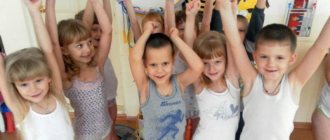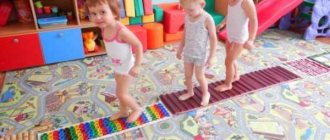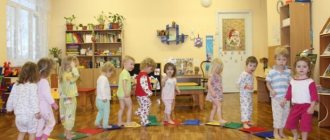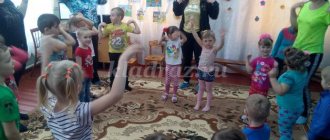Gymnastics after sleep as one of the components of health-saving technologies
I am not afraid to repeat once again: Taking care of health is the most important work of a teacher. Sukhomlinsky Vasily Alexandrovich
Health is a great gift, without which it is difficult to make life happy, interesting and long. A healthy child is easier to raise, teach and educate. He develops the necessary skills and abilities faster. He adapts better to changing conditions and adequately perceives the demands placed on him. Health is the most important prerequisite for the formation of character, the development of will, and natural abilities. Currently, one of the priority tasks facing teachers is to preserve the health of children in the process of education and training. The methodological development I have presented is aimed at solving this problem. It presents ways to organize and conduct gymnastics after sleep. A consultation for parents has been developed. The formation of a healthy lifestyle should begin in kindergarten. There are no trifles in this matter. All life activities of a child in a preschool institution should be aimed at maintaining and strengthening health. Gymnastics after sleep is one of the most important building blocks in establishing the foundation of children’s health, which can only be strengthened if carried out systematically. It is difficult to overestimate the role of daytime sleep in the physical and intellectual development of a child. He simply needs a rest in the middle of the day. After a nap, children wake up lethargic and have low performance, as muscle tone is relaxed. All organs and systems (cardiovascular, respiratory, nervous, etc.) are not prepared for the stress that the child’s body will have to overcome during activities in the evening. But how can you help children wake up in a good mood and actively continue the day? Do gymnastics with your children after a quiet hour after bedtime. Gymnastics after daytime sleep is a set of activities that facilitate the transition from sleep to wakefulness. Invigorating gymnastics helps the child’s body wake up, improves mood, and improves muscle tone. After good gymnastics, children’s feelings of drowsiness, lethargy, and weakness disappear, mental and physical performance and activity increase, and the child’s mood and well-being improve. Gymnastics after a nap is a hardening procedure. The purpose of such gymnastics is to promote the quick and comfortable awakening of children after sleep. The objectives of gymnastics after sleep:
- increase the tone of the nervous system;
- strengthen muscle tone;
- contribute to the prevention of musculoskeletal disorders;
- help prevent colds;
- development of physical skills;
- maintain positive emotions when performing physical exercises and other routine moments in the afternoon.
Solving these problems allows you to smoothly and at the same time quickly increase the mental and physical performance of the child’s body. Gymnastics after sleep, its organization and implementation . The transition from the sleep state to the waking state occurs gradually. To facilitate the transition from a state of rest after waking up to a state of active wakefulness, you can turn on music. Music has a positive effect on children's emotions, creates a good mood in them, instills cheerfulness and joy, helps the rhythm of movements, and makes them easier to perform. Children learn to listen to music and coordinate movements with its character, to perform movements expressively and smoothly. It’s good if, after waking up, children hear their favorite children’s songs or calm, pleasant music, then they will wake up much faster. Don't forget to smile. The first thing a child should see after sleep is the smiling face of an adult, and also hear smooth, measured speech, pleasant intonations, and diminutive suffixes. Children subtly feel the emotions of others. An adult needs to be attentive to himself, monitor his facial expressions and emotional state. Children absorb the excitement, anxiety, irritability, and uncertainty of an adult immediately, like a sponge. All experiences will immediately affect the children’s mood. Invigorating gymnastics should be carried out in a well-ventilated area for seven to fifteen minutes, depending on the age of the children. A prerequisite for gymnastics is taking into account the individual characteristics of each child. Gymnastics consists of several parts:
- warm-up exercises in bed;
- performing simple self-massage (finger exercises) or acupressure;
- performing general developmental exercises at the crib (breathing exercises);
- walking on massage mats;
- Gymnastics can end with wiping with cold water or dousing (arms or legs).
In addition to general health-improving goals, each of the structural parts of invigorating gymnastics also solves its own narrower, specific tasks: Part I - gymnastics in cribs - gymnastics in bed is aimed at the gradual transition of children from sleep to wakefulness. It is better to spend it with the children who have woken up; the rest join in as they wake up. Gymnastics in bed can include elements such as stretching, alternately and simultaneously raising and lowering the arms and legs, elements of finger gymnastics, eye gymnastics, etc. The main rule is to exclude sudden movements that can cause muscle strain, overexcitation, and blood pressure drop. pressure and, as a result, dizziness. The duration of gymnastics in bed is about 2-3 minutes. Part II - corrective exercises, hardening procedures - is aimed at preventing flat feet and scoliosis, training children in basic movements (walking on toes, heels, on the outer and inner sides of the foot, with high knees, etc.), providing a hardening effect on the body. This part of the gymnastics is carried out in a well-ventilated group room using massage mats made by the children's parents. Part III – the final one – increases the child’s physical and emotional tone, creates a positive emotional mood in the group, and encourages further active activity. It can be carried out on the basis of game-type gymnastics using 3-6 simulation exercises. Gymnastics of a playful nature have a plot, they contain characters familiar to children, who are role models for the movements of birds, animals, plants, and children create various images (“skier”, “skater”, “gymnast”, “parsley”, “flower” and etc.). By adopting a certain play image, children often better understand the technique of performing a particular exercise. Children of middle and senior preschool age are very fond of invigorating gymnastics complexes in the form of musical and rhythmic exercises. Dance movements mobilize physical strength, develop grace and coordination of movements, strengthen muscles, and improve breathing. You can also use complexes with elements of acupressure, self-massage, and finger exercises. The essence of acupressure is reduced to mechanical irritation of biologically active points on the body that increase immunity. Carrying out gymnastics after a nap in a playful way allows you to create a positive emotional background and arouse increased interest in all health procedures. Thus, several problems are solved simultaneously: improving the health of children, developing their motor imagination, and developing meaningful motor skills. And most importantly, all this gives children great pleasure. All exercises are carried out at a free pace, without coercion. Each child performs exercises to the extent that is accessible and enjoyable to him. If a child for some reason does not want to perform an exercise, he can simply observe the execution, or perform it partially. The duration of the gymnastics is 7-12 minutes. This is determined by the age of the children and their state of health. It is advisable to use different versions of invigorating gymnastics throughout the year. Thus, daily performance of a complex of gymnastics, developed taking into account the patterns of functioning of the body after sleep and the individual characteristics of the child’s body, allows you to prepare the body for upcoming mental, physical and emotional stress, is a good means of preserving and strengthening health, preventing flat feet, provides high mental and physical performance during the second half of the day. Gymnastics after a nap increases the child’s overall level of physical activity, reducing the adverse effects of a sedentary lifestyle. A well-designed gymnastics complex does not cause negative emotions, at the same time it improves the mood, well-being and activity of the child, the tone of the central nervous system and increases the overall resistance of the body. The system of invigorating gymnastics built in this way helps the child’s body gradually and gently transition from sleep to active wakefulness with a simultaneous health-improving effect. Consultation for parents. INVOLVING GYMNASTICS AFTER SLEEP We all know the expression “got off on the wrong foot.” The mood that these words characterize is also familiar. Kindergarten teachers strive to ensure that children wake up after a nap in a good mood, cheerful and energetic. And parents should strive for this at home. Awakening is one of the most important moments contributing to the normal course of vital processes for the child. For this purpose, after daytime sleep, invigorating gymnastics is carried out; it is aimed at a gradual transition from sleep to wakefulness. It includes the following elements:
- stretching,
- alternately raising and lowering arms, legs,
- elements of self-massage,
- elements of finger gymnastics,
- gymnastics for the eyes,
- elements of breathing exercises.
The main rule is to avoid sudden movements that can cause muscle strain, overexcitation and, as a result, dizziness. Then invite the child to walk barefoot in panties:
- on toes,
- heels,
- on the outer and inner sides of the foot,
- with high knees,
- on massage mats.
In this case, you need to monitor the child’s posture and the correct execution of the exercises. Next, you can move on to performing a complex of breathing exercises, which is very important for:
- strengthening the immune system,
- prevention of colds,
- prevention of upper respiratory tract diseases.
At the end of the gymnastics, carry out water procedures (washing with cool water). It’s good if, after waking up, the child hears his favorite children’s songs, then he will probably wake up faster. In order to evoke an emotional response in children, you can use game exercises accompanied by various poems. For example:
Rules for conducting invigorating gymnastics
The complex of gymnastics after sleep and the hardening method are reflected in the folder “Recreational work in the middle group.”
Next, the children go back to the “Warm” room, where they perform, for example, several physical education sessions or a set of exercises aimed at preventing postural disorders.
Due to the fact that when a group is attended by 20-30 children, in practice it is difficult to effectively harden children during gymnastics after sleep, taking into account the requirements. There can be no talk of an individual approach when carrying out hardening. While the children are sleeping, the teacher creates conditions for contrasting hardening of the children: prepares a “cold” room (playroom or locker room, depending on the layout of the kindergarten building); With the help of ventilation, the temperature in it is initially reduced by 3-5 degrees compared to a “warm” room. Children wake up to the sounds of smooth music, the volume of which slowly increases.





